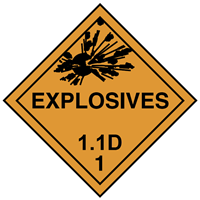
 Print
Print
Chemical Datasheet
CYCLOTETRAMETHYLENE TETRANITRAMINE, [WET WITH >= 10% WATER] |

|
Chemical Identifiers
| CAS Number |
UN/NA Number |
DOT Hazard Label |
USCG CHRIS Code |
|
|
|
|
none
|
| NIOSH Pocket Guide |
International Chem Safety Card |
|
none
|
- CYCLOTETRAMETHYLENE TETRANITRAMINE
|
NFPA 704
data unavailable
General Description
A white crystalline solid. Melting point 281°C. Practically insoluble in water. Water slurry mitigates explosion hazard. Used in solid propellants and explosives. The primary hazard is the blast effect and not flying projectiles and fragments.
Hazards
Reactivity Alerts
Air & Water Reactions
Insoluble in water.
Fire Hazard
Excerpt from ERG Guide 112 [Explosives - Division 1.1, 1.2, 1.3 or 1.5]:
MAY EXPLODE AND THROW FRAGMENTS 1600 METERS (1 MILE) OR MORE IF FIRE REACHES CARGO. (ERG, 2024)
Health Hazard
Excerpt from ERG Guide 112 [Explosives - Division 1.1, 1.2, 1.3 or 1.5]:
Fire may produce irritating, corrosive and/or toxic gases. (ERG, 2024)
Reactivity Profile
CYCLOTETRAMETHYLENE TETRANITRAMINE, [WET WITH >= 10% WATER] is a high explosive. May begin a vigorous reaction that culminates in a detonation if mixed with reducing agents, including hydrides, sulfides and nitrides. May explode in the presence of a base such as sodium hydroxide or potassium hydroxide even in the presence of water. Presence of metal oxides increases thermal sensitivity. Wetting reduces sensitivity toward detonation.
Belongs to the Following Reactive Group(s)
- Azo, Diazo, Azido, Hydrazine, and Azide Compounds
- Nitro, Nitroso, Nitrate, and Nitrite Compounds, Organic
- Water and Aqueous Solutions
Potentially Incompatible Absorbents
Use caution: Liquids with this reactive group classification have been
known to react with the
absorbents
listed below.
- Cellulose-Based Absorbents
- Expanded Polymeric Absorbents
Response Recommendations
Isolation and Evacuation
Excerpt from ERG Guide 112 [Explosives - Division 1.1, 1.2, 1.3 or 1.5]:
IMMEDIATE PRECAUTIONARY MEASURE: Isolate spill or leak area immediately for at least 500 meters (1/3 mile) in all directions.
LARGE SPILL: Consider initial evacuation for 800 meters (1/2 mile) in all directions.
FIRE: If rail car or trailer is involved in a fire, ISOLATE for 1600 meters (1 mile) in all directions; also, initiate evacuation including emergency responders for 1600 meters (1 mile) in all directions. (ERG, 2024)
Firefighting
Excerpt from ERG Guide 112 [Explosives - Division 1.1, 1.2, 1.3 or 1.5]:
CARGO FIRE: DO NOT fight fire when fire reaches cargo! Cargo may EXPLODE! Stop all traffic and clear the area for at least 1600 meters (1 mile) in all directions and let burn. Do not move cargo or vehicle if cargo has been exposed to heat.
TIRE OR VEHICLE FIRE: Use plenty of water - FLOOD it! If water is not available, use CO2, dry chemical or dirt. If possible, and WITHOUT RISK, use unmanned master stream devices or monitor nozzles from maximum distance to prevent fire from spreading to cargo area. Pay special attention to tire fires as re-ignition may occur. Stand by, at a safe distance, with extinguisher ready for possible re-ignition. (ERG, 2024)
Non-Fire Response
Excerpt from ERG Guide 112 [Explosives - Division 1.1, 1.2, 1.3 or 1.5]:
ELIMINATE all ignition sources (no smoking, flares, sparks or flames) from immediate area. All equipment used when handling the product must be grounded. Do not touch or walk through spilled material. DO NOT OPERATE RADIO TRANSMITTERS WITHIN 100 METERS (330 FEET) OF ELECTRIC DETONATORS. DO NOT CLEAN-UP OR DISPOSE OF, EXCEPT UNDER SUPERVISION OF A SPECIALIST. (ERG, 2024)
Protective Clothing
Excerpt from ERG Guide 112 [Explosives - Division 1.1, 1.2, 1.3 or 1.5]:
Wear positive pressure self-contained breathing apparatus (SCBA). Structural firefighters' protective clothing provides thermal protection but only limited chemical protection. (ERG, 2024)
DuPont Tychem® Suit Fabrics
No information available.
First Aid
Excerpt from ERG Guide 112 [Explosives - Division 1.1, 1.2, 1.3 or 1.5]:
Refer to the "General First Aid" section. (ERG, 2024)
Physical Properties
Flash Point: data unavailable
Lower Explosive Limit (LEL): data unavailable
Upper Explosive Limit (UEL): data unavailable
Autoignition Temperature: data unavailable
Melting Point: data unavailable
Vapor Pressure: data unavailable
Vapor Density (Relative to Air): data unavailable
Specific Gravity: data unavailable
Boiling Point: data unavailable
Molecular Weight: data unavailable
Water Solubility: data unavailable
Ionization Energy/Potential: data unavailable
IDLH: data unavailable
AEGLs (Acute Exposure Guideline Levels)
No AEGL information available.
ERPGs (Emergency Response Planning Guidelines)
No ERPG information available.
PACs (Protective Action Criteria)
| Chemical |
PAC-1 |
PAC-2 |
PAC-3 |
| Cyclotetramethylene tetranitramine; (HMX) (2691-41-0)
|
19 mg/m3 |
210 mg/m3 |
1300 mg/m3 |
(DOE, 2024)
Regulatory Information
EPA Consolidated List of Lists
No regulatory information available.
CISA Chemical Facility Anti-Terrorism Standards (CFATS)
|
RELEASE |
THEFT |
SABOTAGE |
| Chemical of Interest |
CAS Number |
Min Conc |
STQ |
Security
Issue |
Min Conc |
STQ |
Security
Issue |
Min Conc |
STQ |
Security
Issue |
| HMX; [Cyclotetramethylene-tetranitramine] |
2691-41-0 |
ACG |
5000 pounds |
explosive |
ACG |
400 pounds |
EXP/IEDP |
|
|
|
(CISA, 2007)
OSHA Process Safety Management (PSM) Standard List
No regulatory information available.
Alternate Chemical Names
- BETA-HMX
- CYCLOTETRAMETHYLENE TETRANITRAMINE, [WET WITH >= 10% WATER]
- CYCLOTETRAMETHYLENETETRANITRAMINE
- HMX
- HMX 2
- HOMOCYCLONITE
- HW 4
- IRX 21
- JO 9159
- JO-X
- LX 14
- LX 14-0
- OCTAHYDRO-1,3,5,7-TETRANITRO-1,3,5,7-TETRAZOCINE
- OCTAHYDRO-1,3,5,7-TETRANITRO-S-TETRAZOCINE
- OCTOGEN
- OKTOGEN
- ORA 86B
- PBXC 121
- PBXC 126
- PBXC 129
- PBXK-C 1203
- PBXN 101
- PBXN 110
- PBXN 5
- PBXN 9
- PBXW 11
- PBXW 113
- PBXW 128
- RENOWEX 1001
- ROWANEX 2000
- ROWANEX 3000
- SW 21
- TETRAMETHYLENETETRANITRAMINE
- 1,3,5,7-TETRANITRO-1,3,5,7-TETRAAZACYCLOOCTANE
- 1,3,5,7-TETRANITRO-1,3,5,7-TETRAZOCANE


 Print
Print
